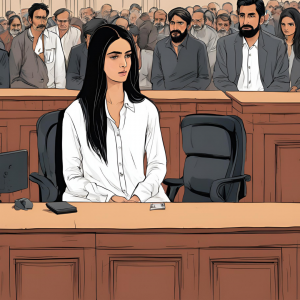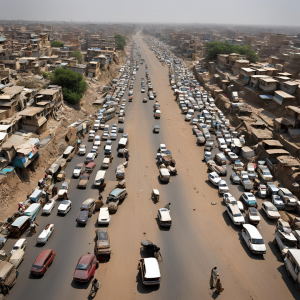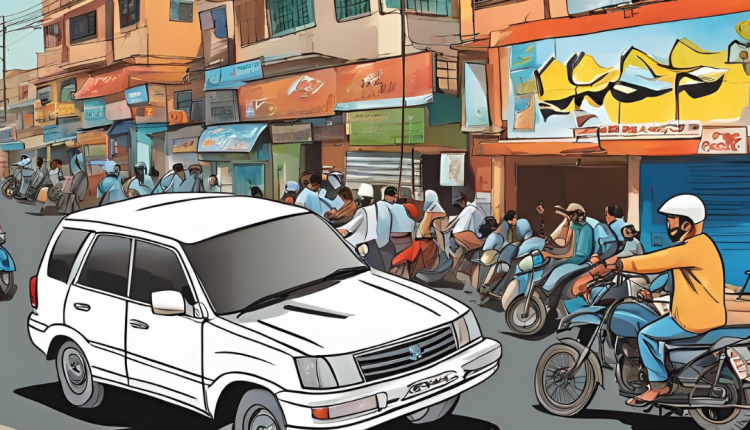Tragedy Strikes on Karsaz Road
Examining the Fallout from the Karsaz Accident
The bustling city of Karachi, known for its vibrant culture and relentless pace, has long been a city of contrasts. Amid its colorful life and dynamic energy lies the shadow of danger, particularly on its chaotic streets. On August 19, 2024, this shadow took on a deadly form as a tragic accident on Karsaz Road claimed the lives of two individuals and left several others injured. This incident has become a focal point for discussions around road safety, legal accountability, and the broader implications of such tragedies in urban Pakistan.
Karachi’s roads are infamous for their unpredictability, and the events that unfolded on Karsaz Road serve as a grim reminder of the daily risks that residents face. In a city teeming with people and vehicles, a moment of negligence or recklessness can lead to catastrophic outcomes. The Karsaz accident is not merely an isolated tragedy; it’s a symptom of systemic issues that urgently need addressing.
Seeking Justice in the Courts
On that fateful day, a speeding vehicle driven by Natasha Danish Iqbal faced down Karsaz Road, ultimately crashing into 60-year-old Imran Arif and his daughter, Amna Arif. The violent impact of the crash injured five others and caused extensive property damage. Witnesses reported that the vehicle was traveling at an estimated 100 kilometers per hour, far exceeding the speed limit of 30-40 kilometers per hour in the area. The driver’s loss of control led to the catastrophic accident, now a subject of intense legal scrutiny.
Natasha was immediately taken into custody and charged under Section 322 of the Pakistan Penal Code, which pertains to culpable homicide. This non-bailable offense underscores the severity of the charges, as it covers incidents where death results from an act done without intent to cause harm but still constitutes a grave breach of safety regulations. Initially, Natasha’s defense rested on claims of mental instability, but these were contradicted by medical professionals who declared her fit and stable.

The legal process has been anything but straightforward. Natasha’s inconsistent statements have raised questions about the reliability of her account and the true circumstances of the accident. Additionally, the involvement of a private company, under which the vehicle was registered, adds another layer of complexity to the case. Natasha is the wife of Danish Iqbal, the current Chairman of Gul Ahmed Energy Limited, and holds important board positions herself. Initially, police investigations focused on gathering CCTV footage and conducting blood tests to determine whether Natasha was under the influence of any substances at the time of the crash. The private company’s involvement also raised questions about corporate responsibility. Often, companies that provide vehicles for high-profile individuals may not enforce stringent checks on driving behavior or mental fitness. This incident could set a precedent for how such cases are handled in the future, potentially leading to more rigorous regulations and oversight of corporate policies.
Blurred Lines of Justice
The case has now taken a new turn as police have filed additional charges under the Hudood law. Danish, who was reportedly driving under the influence of methamphetamine (crystal meth) at the time of the accident, had previously been arrested and charged with manslaughter after her vehicle collided with motorcycles and another car, resulting in two fatalities and three injuries.
Despite the initial charges, a fresh First Information Report (FIR) has been registered under Section 11 of the Prohibition (Enforcement of Hadd) Order (PEHO) of 1979, which deals with drinking and being under the influence of substances liable for tazir (a discretionary punishment under Islamic law). This move followed the confirmation from medical reports that Danish had methamphetamine in her system during the accident.
The legal justification for invoking the Hudood law has raised questions. Lawyer Jibran Nasir pointed out that crystal meth is classified as a prohibited drug under the Control of Narcotics Substances Act 1997, and its consumption is an offense under the Control of Narcotics Substances Amendment Act 2022. Furthermore, driving under the influence of drugs is a crime under the Provincial Motor Vehicle Ordinance 1965.
Nasir expressed confusion over the application of the Hudood law in this case, as crystal meth is not listed in the schedule of prohibited substances under the PEHO. He emphasized that the Hudood law should only apply if the substances consumed are specifically included in its schedule.
A Call for Compensation
On September 5, 2024, the family of the victims chose to forgive Natasha Danish Iqbal. On Friday, the heirs expressed no objection to her bail request in court, stating that the accident was unintentional and that they had reached an agreement with the suspect. In an affidavit to be submitted during the bail hearing, the family, including Imran Arif’s son Usama, his wife, and daughter, declared, “We have pardoned the suspect in the name of Allah, the most merciful and compassionate.” They emphasized that the decision was made voluntarily and without external pressure, citing the Islamic principle of Diyat—a provision in Sharia law that allows the victim’s family to forgive the offender in exchange for compensation or as an act of mercy. This statement effectively clears the path for the court to grant bail, marking a significant development in the case.
The Human Toll of Negligence
While the legal proceedings capture public attention, the accident’s human cost is immeasurable. Imran Arif, a respected figure in his community, and his daughter Amna were beloved members of their family, and their loss has left a void that cannot be filled. The emotional toll on their relatives is profound, as they grapple with the sudden and violent nature of their loved ones’ deaths.
The tragedy also raises broader questions about the state of road safety in Karachi. In a city where traffic regulations are often flouted and enforcement is lax, the potential for such accidents is ever-present. The Karsaz accident has not only brought grief to one family but has also instilled a sense of fear and vulnerability in the broader public. If such incidents can happen to anyone, at any time, then who is truly safe on Karachi’s roads?
The emotional impact of the accident has been felt far beyond the immediate circle of the victims’ families. It has resonated with the public at large, many of whom see themselves or their loved ones in the victims. This collective grief has fueled calls for change, as citizens demand better protection and accountability from those responsible for maintaining road safety.
The Rich Get Away, the Poor Pay
The Karsaz tragedy is a stark reminder of the vast divide between the rich and the poor in our country. When someone like Natasha, from an elite and influential family, is involved, the situation often takes a different turn. The wealthy have the means to manipulate the judicial system, using their power, money, and connections to escape the consequences of their actions. This creates a dangerous monopoly over justice, where the rules can be bent, delayed, or even ignored entirely.
In a country where the rich can afford top lawyers, influence investigations, and pressure witnesses, justice becomes a commodity that the poor can’t afford. The victims’ families are left in the lurch, struggling to find a voice in a system that seems designed to favor those with deep pockets. It is not just about the legal battles—they also face social pressures, where the fear of going up against powerful figures can be overwhelming.
This disparity does not just highlight inequality; it entrenches it. When the rich repeatedly get away with their crimes, it sends a clear message: the law is not the same for everyone. The powerful can live above it, while the common person is left to navigate a broken system, hoping for a justice that is often out of reach.
Karachi’s Traffic Woes Laid Bare
Karachi’s traffic system has long been criticized for its lack of regulation and enforcement. With a population exceeding 15 million, the city’s roads are often a battleground of vehicles, pedestrians, and vendors, each vying for space in a congested environment. The Karsaz accident is not an isolated incident but rather a symptom of a much larger problem that plagues the city’s infrastructure.
Over the years, numerous accidents have occurred on Karachi’s roads, often involving speeding, reckless driving, and poor road conditions. Despite repeated calls for reform, little has changed, and the result is a growing sense of vulnerability among the city’s residents. The Karsaz tragedy has once again highlighted the urgent need for comprehensive traffic management strategies, better road maintenance, and stricter enforcement of traffic laws.
A City at a Crossroads
The issue of Karachi’s traffic woes is multifaceted. On one hand, there’s the sheer volume of vehicles on the roads, which makes accidents more likely. On the other hand, there’s the behavior of drivers, many of whom ignore traffic rules with impunity. This is compounded by inadequate infrastructure, such as poorly maintained roads and a lack of proper signage, which further contributes to the risk of accidents.

Another factor to consider is the role of law enforcement. In many cases, traffic police in Karachi are either understaffed or under-resourced, making it difficult for them to effectively monitor and regulate traffic. Additionally, corruption within the system can lead to leniency for those who can afford to pay bribes, further eroding the rule of law. The result is a system that is not only inefficient but also deeply unfair, with ordinary citizens bearing the brunt of the consequences.
Public Outcry for Accountability
In the wake of the accident, public reaction has been swift and vocal. Citizens have taken to social media to express their anger and frustration over the state of road safety in Karachi. Many have pointed out that accidents like the one on Karsaz Road are preventable if the city’s traffic laws were enforced more rigorously.
The case has also put a spotlight on the issue of accountability, with many questioning whether justice will be served in a country where powerful individuals often evade punishment. The involvement of a private company in the case, coupled with the suspect’s alleged connections, has led to concerns that the investigation might be influenced by external pressures.
Social media has played a crucial role in amplifying the public’s demands for accountability. Hashtags related to the Karsaz accident have trended on Twitter, with users sharing their thoughts and demanding justice for the victims. This digital activism has helped keep the issue in the public eye, putting pressure on the authorities to take the case seriously and ensure that justice is served.
The outcry has also led to a broader conversation about the state of governance in Pakistan. Many citizens feel that the government has failed to protect them, whether it’s on the roads or in other areas of public safety. The Karsaz accident has become a symbol of this failure, galvanizing people to demand not only justice for the victims but also systemic reforms to prevent such tragedies in the future.
Media in the Spotlight
The media’s role in covering the Karsaz accident has been significant in shaping public perception. From the initial reports of the crash to the ongoing legal battle, the media has kept the story in the public eye, ensuring that it remains a topic of discussion. However, this coverage has also raised ethical questions about the balance between reporting facts and sensationalizing tragedy.
Some media outlets have been criticized for focusing more on the sensational aspects of the case, such as the suspect’s personal life and mental health, rather than the broader issues of road safety and legal reform. This has led to calls for more responsible journalism that prioritizes the public good over ratings.
On the other hand, some media outlets have been praised for their in-depth reporting and analysis, which has helped to shed light on the systemic issues that contributed to the accident. By exploring the root causes of Karachi’s traffic woes and highlighting the failures of the legal system, these outlets have played a crucial role in advancing the conversation about road safety in Pakistan.
The media’s coverage of the Karsaz accident also highlights the power of the press in holding the powerful accountable. In a country where corruption and impunity are often the norm, the media can serve as a watchdog, ensuring that those responsible for crimes are not allowed to escape justice. However, this power comes with a responsibility to report the facts accurately and fairly, without resorting to sensationalism or exploitation.
Lessons from the Road
The Karsaz accident serves as a grim reminder of the dangers that Karachi’s roads pose to its residents. It underscores the need for immediate action to improve road safety and prevent such tragedies from occurring in the future. Key lessons that can be drawn from this incident include:
Enhanced Traffic Law Enforcement: There is a clear need for stricter enforcement of traffic laws, including speed limits and regulations on driving under the influence of alcohol or drugs. This could involve increased police presence on major roads and the use of technology, such as speed cameras, to monitor and deter reckless driving.
Improved Road Infrastructure: Karachi’s road infrastructure is in dire need of upgrades to ensure the safety of all road users. This includes better signage, road maintenance, and the creation of designated pedestrian zones.
Public Awareness Campaigns: Raising awareness about the importance of road safety can play a crucial role in preventing accidents. Public service announcements, educational programs, and community initiatives can help instill a culture of responsible driving in the city.
Judicial Accountability: The legal system must ensure that those responsible for accidents are held accountable, regardless of their social standing. This includes fair and transparent trials, as well as appropriate penalties for those found guilty.
Corporate Responsibility in Focus: The involvement of a private company in the Karsaz accident brings corporate responsibility into sharp focus. When companies provide vehicles to their employees, they must ensure that these individuals are fit to operate them safely. This includes conducting regular mental and physical health assessments, as well as implementing strict policies regarding driving behavior. The Karsaz case could set a precedent for how corporate entities are held accountable in the event of such accidents, potentially leading to stricter regulations and oversight.
A Call for Change
The Karsaz Road accident is a tragic reminder of the vulnerabilities faced by Karachi’s residents every day. It highlights the urgent need for comprehensive reforms in traffic management, law enforcement, and corporate responsibility. While justice for the victims remains paramount, the broader lesson from this tragedy is the necessity of systemic change to prevent future accidents.
Public pressure, media scrutiny, and legal action may combine to bring about these changes, but it requires a collective effort from all stakeholders—government, corporations, and citizens alike. Only through such a concerted effort can we hope to make Karachi’s roads safer for everyone.

